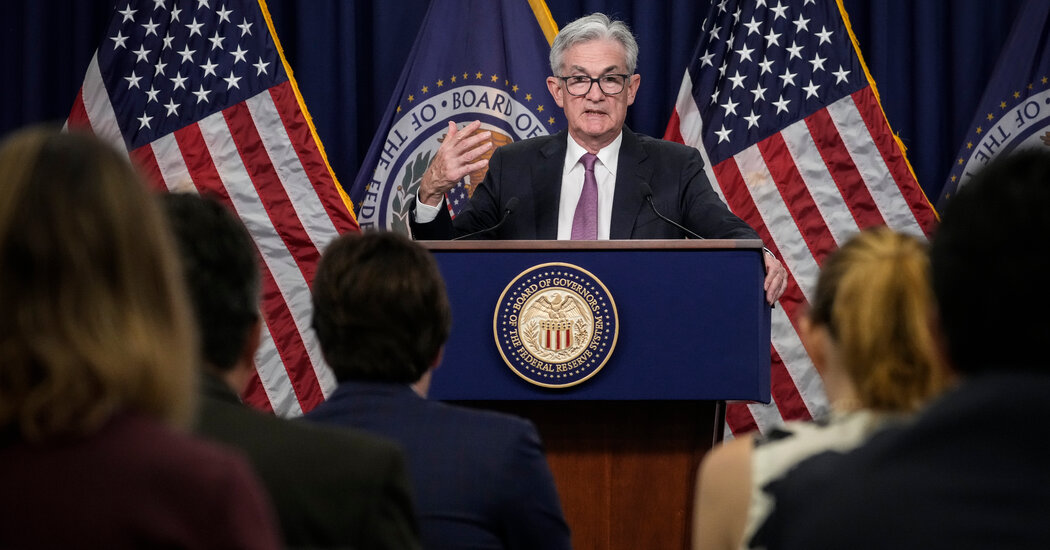Federal Reserve officials on Tuesday made clear that they expected to continue raising rates to try to choke off the most rapid inflation in decades, putting them at odds with investors who had become more sanguine about the outlook for interest rate moves.
Stocks prices rose following the Fed’s meeting last week, as investors celebrated what some interpreted as a pivot: Jerome H. Powell, the Fed chair, said the central bank would begin making rate decisions on a meeting-by-meeting basis, which Wall Street took as a signal that its rate moves might soon slow down.
But a chorus of Fed officials has since made clear that a lurch away from rate increases is not yet in the cards.
Mary C. Daly, the president of the Federal Reserve Bank of San Francisco, said in an interview on LinkedIn on Tuesday that the Fed was “nowhere near” done raising interest rates. Charles L. Evans, the president of the Federal Reserve Bank of Chicago, told reporters that he would favor a half- or even a three-quarter-point rate increase in September.
Neel Kashkari, the president of the Federal Reserve Bank of Minneapolis, said in an interview late last week that he did not understand why markets were dialing back their expectations for Fed rate increases.
8 Signs That the Economy Is Losing Steam
Worrying outlook. Amid persistently high inflation, rising consumer prices and declining spending, the American economy is showing clear signs of slowing down, fueling concerns about a potential recession. Here are other eight measures signaling trouble ahead:
Those comments suggest that the central bank remains resolute in its plans to push up borrowing costs, slow the economy and restrain inflation. And they were notable given that all three officials have historically favored low interest rates. That they remain committed to raising borrowing costs underscores that the Fed is united in its push to lower price increases.
The Fed’s work is “nowhere near almost done,” Ms. Daly said, adding, “We’ve been with this high inflation for a while, and really getting too confident that we’ve already solved the problem, I think, would be a mistake.”
Stock and key government bond prices fell on Tuesday partly because markets reacted to the Fed commentary.
The Fed’s most recent forecasts, released in June, projected that officials would raise interest rates to 3.4 percent by the end of the year, up a full percent from their current range of 2.25 to 2.5 percent. Mr. Evans suggested on Tuesday that he still thought that path was reasonable.
Investors generally expect the Fed to stick to the course it outlined in June. But after last week’s Fed meeting, they began placing increasing odds on the possibility that the central bank would raise rates by less than forecast. In fact, market pricing began to suggest that some investors had slightly raised the odds that the Fed would cut rates next year, something officials have pushed back on.
“That’s a puzzle to me. I don’t know where they find that in the data,” Ms. Daly said. “The outlook I think is most likely is really that we raise interest rates, and then we hold them there for a while.”
Officials will release their next set of rate projections at their meeting in September.
Both Mr. Kashkari and Mr. Evans suggested that they would favor a half-point increase in September — a slight slowdown from the three-quarter-point increases officials made in June and July — but that a third unusually large rate increase was possible.
In September, “50 is a reasonable assessment, but 75 could also be OK,” Mr. Evans told reporters on Tuesday.
Understand Inflation and How It Impacts You
Officials are trying to restrain the economy enough to slow the labor market, cool off wage growth and reduce demand so that prices moderate. They continue to hope that they can pull that off without plunging the economy into an outright recession.
But central bankers are very cognizant that prices, which rose by 9.1 percent in the year through June, have been climbing rapidly for more than a year. Consumers might begin to expect faster inflation and shift their behavior in ways that make price increases more likely to last.
There are signs that the economy is slowing as inflation weighs on American pocketbooks, and data released by the Federal Reserve Bank of New York on Tuesday showed that households were taking on more debt as they tried to shoulder climbing prices. But it is not yet clear that a downturn has begun.
“Seeing some pullback in activity is actually what we wanted to see,” Loretta J. Mester, the president of the Federal Reserve Bank of Cleveland, said during a Washington Post Live interview on Tuesday. “Certainly, it hasn’t slowed enough (a) to call it a recession and (b) to see that moderation in demand” is carrying over to moderation in price increases.
Ms. Mester, as her colleagues did, suggested that interest rates had more room to rise and that she was looking for a clear slowdown in inflation. She said that seeing one month of downward movement — and she cited a potential drop in inflation in July because oil prices had come down — would not be enough.
“You wouldn’t want to conclude too quickly that inflation is on a downward path, because of how high it is,” she said. “I want to see it broadly, across many inflation measures — not just one, not just two.”

